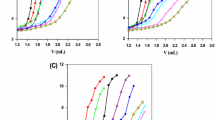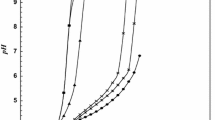Summary
Potentiometric equilibrium measurements have been made at 25.0±0.1 °C and ionic strengthI=0.1 mol dm−3 KNO3 for the interaction of adenosine 5′-mono-, 5′-di-, and 5′-triphosphate (AMP,ADP andATP) and Cu(II) with biologically important secondary ligand zwitterionic buffers (N,N-bis-(2-hydroxyethyl)-2-aminoethanesulphonic acid (BES), N-tris-(hydroxymethyl)-methyl-2-aminoethanesulphonic acid (TES), N,N-bis-(2-hydroxyethyl)-glycine (Bicine) andtris-(hydroxymethyl)-methylaminopropane sulphonic acid (TAPS)) in a 1:1:1 ratio and the formation of various 1:1:1 mixed ligand complex species inferred from the potentiometricpH titration curves. Initial estimates of the formation constants of the resulting species and the acid dissociation constants ofAMP,ADP,ATP, and secondary ligands have been refined with the SUPERQUAD computer program. Negative and positive Δ logK values were obtained for the ternary systems studied. In some Cu(II) ternary systems studied the interligand interactions or some cooperativity between the coordinate ligands, possibly H bond formation, has been found to be most effective in deciding the stability of the ternary complexes formed in solution. Stabilities of mixed ligand complexes increase in the orderAMP<ADP<ATP. The trend in stability constants of the mixed-ligand complexes of the title zwitterionic buffer ligands is found to beTAPS>Bicine>TES>BES.
Zusammenfassung
Die Wechselwirkungen zwischen Adenosin-5′-mono, -5′-di- und-5′-triphosphat (AMP,ADP undATP), Cu(II) und biologisch wichtigen zwitterionischen Puffern mit Sekundärligandeigenschaften (N,N-bis-(2-Hydroxyethyl)-2-aminoethansulfonsäure (BES), N-tris-(Hydroxymethyl)-methyl-2-aminoethansulfonsäure (TES), N,N-bis-(2-Hydroxyethyl)-glycin (Bicin) undtris-(Hydroxymethyl)-methylaminopropansulfonsäure (TAPS) im Verhältnis 1:1:1 wurden mittels potentiometrischer Gleichgewichtsmessungen bei 25.0±0.1 °C undI=0.1 mol·dm−3 KNO3 untersucht. Die Titrationskurven lassen auf verschiedene Komplexe mit gemischten Liganden im Verhältnis von 1:1:1 schließen. Erste Abschätzungen der Bildungskonstanten der entstehenden Produkte und der Dissoziationskonstanten vonAMP,ADP,ATP und der Sekundärliganden wurden mit HIlfe des Programms SUPERQUAD verfeinert. Für die untersuchten ternären Systeme wurden negative und positive Werte für Δ logK erhalten. In einigen der Cu(II)-Komplexe wird die Stabilität des ternären Systems in Lösung hauptsächlich durch Wechselwirkungen zwischen den Liganden, möglicherweise durch die Ausbildung von Wasserstoffbrückenbindungen, bestimmt. Die Stabilität der Komplexe steigt in der ReihenfolgeAMP<ADP<ATP. Der entsprechende Trend der Stabilitätskonstanten bei den gemischten Komplexen mit den im Titel genannten zwitterionischen Puffern lautetTAPS>Bicin>TES>BES.
Similar content being viewed by others
References
Eichhorn G. L. (ed.) (1973) Inorganic Biochemistry, Vols 1 and 2. Elsevier, New York
Sigel H. (ed.) Metal Ions in Biological Systems; Marcel Dekker, New York (1973–1982; Vols 1–14)
Wood J. M. (1975) Naturwissenschaften62: 357–364
Spiro T. G. (ed.) Phosphate Transfer and Its Activation by Metal Ions; Alkaline Phosphates. Chapter 17 of Ref 1.
Cooperman B. S. (1976) Met. Ions Biol. Syst.5: 79–125
Mildvan A. S. (1979) Adv. Enzymol. Relat. Areas Mol. Biol.49: 103–26
Sigel H. (ed.) (1979) Nucleotides and Derivatives: Their Ligating Ambivalency. Vol 8 of Ref. 2
Colburn R. W., Mass J. W. (1966) Nature208: 37
Sigel H., Becker W., McCormick D. B. (1967) Biochim. Biophys. Acta148: 655
Chaudhuri P., Sigel H. J. (1977) Am. Chem. Soc.99: 3142
Rajan K. S., Mainer S., Davis J. M. (1978) Bioinorg. Chem.9: 187
Yatsimirskii K. B., Davidenko N. K., Manorik P. A. (1978) Dopov. Acad. Nauk Uker RSR, Ser. B. Geol., Khim. Biol. Nauki12: 1111
Mohan M. S., Khan M. M. T. (1979) J. Coord. Chem.8: 207
Arena G., Call R., Cucinotta V., Musumeci S., Rizareli S., Sammartano S. (1980) Congr. Naz. Chim. Inorg. (Atti)13: 288
Bouisson D. H., Sigel H. (1974) Biochim. Biophys. Acta43: 343
Davidenko N. K., Manorik P. A. (1980) Zh. Neorg. Khim.25(2: 437
Saha N., Sigel H. (1982) J. Am. Chem. Soc.104(15: 4100
Manorik P. A., Davidenko N. K. (1983) Zh. Neorg. Khim.28(9: 2292
Werner E. R., Rode B. M. (1984) Inorg. Chim. Acta91: 217
Davidenko N. K., Respopina V. A. (1986) Zh. Neorg. Khim.31(8: 2039
Matsuda K., Kanai C., Takahara M., Maki M. (1985) Nippon Kagoku Kaiski4: 698
Mahmoud M. R., Azab H. A., Hamed M. M. A., Mohamed A. A. (1989) Chem. Scr.29: 17–20
Azab H. A., Hassan Ahmed, El-Nady A. M., Azkal R. S. A. (1993) Monatsh. Chemie124: 267
Azab H. A., El-Nady A. M., Hassan Ahmed, Azkal R. S. A. (1993) Monatsh. Chemie (in press)
Azab H. A., El-Nady A. M., Hassan Ahmed, Azkal R. S. A. (1993) J. Chem. Eng. Data38: 502
Buisson D. H., Sigel H. (1974) Biochim. Biophys. Acta34: 45–63
Perrin D. D., Dempsey B. (1979) Buffers forpH and Metal Ion control. Chapman and Hall, London
De Stefano C., Princi P., Rigano C., Sammartano S. (1987) Ann. Chim. (Rome)77: 643
Gans P., Sabatini A., Vacca A. (1985) J. Chem. Soc., Dalton Trans. 1195
Irving H., Rossotti H. S. (1953) J. Chem. Soc. 3397; 1954, 2904
Schwarzenbach G., Anderegg G., Schneider W., Senn, H. (1955) Helv. Chim. Acta38: 1147
Good N. E., Winget G. D., Winter W., Connolly T. N., Izawa S., Singh R. M. M. (1966) Biochemistry5: 467
Sillen L. G., Martell A. E. (1971) Stability Constants of Metal ion complexes. The Chemical Society, Burlington House, London
Khan M. M. T., Martell A. E. (1967) J. Am. Chem. Soc.89: 5585
Khan M. M. T., Martell A. E. (1966) J. Am. Chem. Soc.88: 668
Smith R. M., Martell A. E., Chen Y. (1991) Pure & Appl. Chem.63: 1015
Levene P. A., Simms H. S. (1925) J. Biol. Chem.65: 519
Taylor H. F. W. (1948) J. Chem. Soc. 765
Alberty R. A., Smith R. M., Bock R. M. (1951) J. Biol. Chem.193: 425
Beers R. F., Steiner R. F. (1957) Nature (London)179: 1076
Christensen J. J., Izatt R. M. (1962) J. Phys. Chem.66: 1030
Harkins T. R., Freiser H. (1958) J. Am. Chem. Soc.80: 1132
Albert A. (1953) Biochem. J.54: 646
Albert A., Serjeant E. P. (1960) Biochem. J.76: 621
Frieden E., Alles J. (1957) J. Biol. Chem.230: 797
Eichhorn G. L., Clark P., Becker E. D. (1966) Biochemistry5: 245
Khan M. M. T., Martell A. E. (1962) J. Phys. Chem.66: 10
Cohn M., Hughes T. R. (1962) J. Biol. Chem.237: 176
Brintzinger H. (1963) Biochim. Biophys. Acta77: 343
Berger N. A., Eichhorn G. L. (1971) Biochemistry10: 1847
Bemski G., Rieber M., Wust M. (1971) FEBS Lett.14: 117
Sigel H., Massoud S. S., Tribolet R. J. (1988) J. Am. Chem. Soc.110: 6857
Sigel H. (1987) Eur. J. Biochem.165: 65
Itoh H., Itoh N., Suzuki Y. (1984) Bull. Chem. Soc. Jpn.57: 716
Powell H. K. J., Curtis N. F. (1967) J. Chem. Soc., A., 1441
Author information
Authors and Affiliations
Rights and permissions
About this article
Cite this article
Azab, H.A., El-Nady, A.M. Ternary complexes in solution. Comparison of the coordination tendency of some biologically important zwitterionic buffers toward the binary complexes of Cu(II) and adenosine 5′-mono-, 5′-di-, and 5′-triphosphate. Monatsh Chem 125, 849–858 (1994). https://doi.org/10.1007/BF00812698
Received:
Accepted:
Issue Date:
DOI: https://doi.org/10.1007/BF00812698




